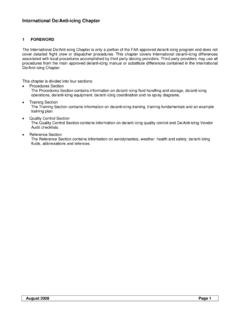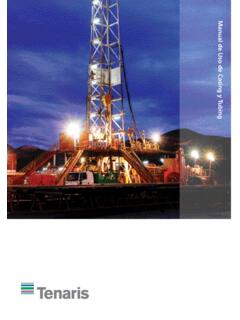Transcription of International Measures of Prevention, Application, and ...
1 International Measures of Prevention, Application, and Economics of corrosion Technologies Study March 1, 2016 Page ii Project Manager Elaine Bowman, Past President, NACE International , Houston, Texas, USA Authors Gerhardus Koch, , FNACE, DNV GL, Dublin, Ohio, USA Jeff Varney, APQC, Houston, Texas, USA Neil Thompson, , FNACE, DNV GL, Dublin, Ohio, USA Oliver Moghissi, , FNACE, DNV GL, Dublin, Ohio, USA Melissa Gould, , DNV GL, Dublin, Ohio, USA Joe Payer, , FNACE, Akron University, Akron, Ohio, USA Technical Advisory Panel Pierre Crevolin, HDIM Protective Coatings, Inc.
2 , Edmonton, Alberta, Canada Roger Francis, FNACE, RFMaterials, Glossop, Derbyshire, United Kingdom Kevin Garrity, FNACE, Mears Group, Inc., Rosebush, Michigan, USA Sylvia Hall, Sylvia Hall Engineering (SHE), Hacienda Heights, California, USA Richard Kinzie, Department of Defense corrosion Office of Policy & Oversight, Washington, DC, USA David Kroon, Aegion Corporation, Houston, Texas, USA Larry Lee, Department of Defense Office of corrosion Policy & Oversight, Washington, DC, USA Frank Rampton, Trenton Corporation, Ann Arbor, Michigan, USA Doni Riddle, Sherwin-Williams Company, Cleveland, Ohio, USA Hiroyuki Tanabe, Dai Nippon Toryo Co.
3 , Ltd., Otawara-Shi, Tochigi-Ken, Japan David Webster, Worley Parsons Canada Services, Ltd., Calgary, Alberta, Canada Editor Gretchen Jacobson, NACE International , Houston, Texas, USA 2016 by NACE International , 15835 Park Ten Place, Houston, TX 77084 International Measures of Prevention, Application, and Economics of corrosion Technologies Study March 1, 2016 Page iii EXECUTIVE SUMMARY NACE International initiated the International Measures of Prevention, Application, and Economics of corrosion Technologies (IMPACT) study to examine the current role of corrosion management in industry and government and to establish best practices.
4 The global cost of corrosion is estimated to be US$ trillion, which is equivalent to of the global Gross Domestic Product (GDP) (2013). By using available corrosion control practices, it is estimated that savings of between 15 and 35% of the cost of corrosion could be realized; , between US$375 and $875 billion annually on a global basis, an astronomical savings. In addition, these costs typically do not include individual safety or environmental consequences. The high cost of corrosion has been known for years; Uhlig performed a comprehensive study in 1949 that revealed a cost of corrosion equivalent to of the GDP.
5 The Global Impact of corrosion The global cost of corrosion is estimated to be US$ trillion, which is equivalent to of the global Gross Domestic Product (GDP) (2013). By using available corrosion control practices, it is estimated that savings of between 15 and 35% of the cost of corrosion could be realized; , between US$375 and $875 billion annually on a global basis, an astronomical savings. In addition, these costs typically do not include individual safety or environmental consequences. The high cost of corrosion has been known for years; Uhlig performed a comprehensive study in 1949 that revealed a cost of corrosion equivalent to of the GDP.
6 The fact that corrosion control provides a cost benefit is a lesson learned over and over again by industry, often too late and following catastrophic events ( , accidents, failures, and loss of production). To achieve the full extent of potential savings, it is the conclusion of this study that implementing a corrosion Management System (CMS) and its integration into an organization s overall management system is mandatory. A difficulty in promoting corrosion management is that cost savings from corrosion control are difficult to measure; , (i) maintenance costs slowly decrease; (ii) monitoring or inspection costs decrease or inspection intervals increase; (iii) fewer failures save lost production time and/or lost product, decrease injuries, decrease in property damage, decrease in environmental release, improved public relations; and (iv) life extension of the asset can go directly to the bottom-line and/or postpone capital expenditures.
7 All of these can be included in the business case for enhanced corrosion management. One corrosion management success story is the change in corrosion management strategy and application of innovative technology in the automotive industry globally. Since 1975, the manufacturers have created a coordinated and balanced effort between advances in design, materials, and processing. This was not a quick turnaround, but one of continuous improvement over a relatively long time period of all aspects of corrosion -related design and processing decisions.
8 The transformation in corrosion management strategy by the automotive industry was a decision at the highest levels of an organization, resulting in lower corrosion -related manufacturing costs, lower corrosion -related operating costs, and longer life of automobiles for the buying public. International Measures of Prevention, Application, and Economics of corrosion Technologies Study March 1, 2016 Page iv corrosion Management System A CMS is a set of policies, processes, and procedures for planning, executing, and continually improving the ability of an organization to manage the threat of corrosion for existing and future assets.
9 In most cases, this includes 1) optimizing corrosion control actions and minimizing life cycle corrosion costs, and 2) meeting safety and environmental goals. Substantially reducing corrosion costs (both direct and indirect) requires more than technology; it requires integrating corrosion decisions into an organizational management system. The IMPACT study provides a CMS framework and guideline to integrate corrosion management elements into an organizational management system; alternatively, it can be used to develop a standalone CMS.
10 This CMS framework is considered a core deliverable of this study. This innovative approach is of greatest value in institutionalizing corrosion management within an organization. Most corrosion professionals currently work within an environment of Procedures and Working Practices, which are in the language of technical contributors ( , not financial or operational decision makers). In some cases, corrosion is included within operating plans ( , asset integrity management plans), which integrates corrosion with other structural integrity threats.



